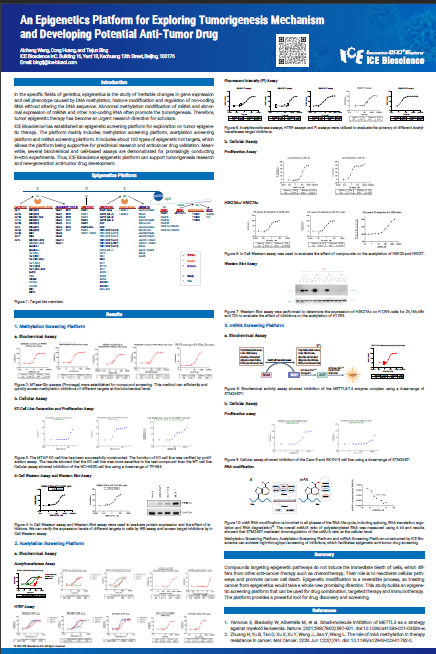
In the specific fields of genetics, epigenetics is the study of heritable changes in gene expression and cell phenotype caused by DNA methylation, histone modification and regulation of non-coding RNA without altering the DNA sequence. Abnormal methylation modification of mRNA and abnormal expression of miRNA and other non-coding RNA often promote the tumorigenesis. Therefore, tumor epigenetic therapy has become an urgent research direction for scholars.
ICE Bioscience has established an epigenetic screening platform for exploration on tumor epigenetic therapy. The platform mainly includes methylation screening platform, acetylation screening platform and mRNA screening platform. It includes about 100 types of epigenetic hot targets, which allows the platform being supportive for preclinical research and anticancer drug validation. Meanwhile, several biochemical and cell-based assays are demonstrated for promisingly conducting in-vitro experiments. Thus, ICE Bioscience epigenetic platform can support tumorigenesis research and new-generation anti-tumor drug development.

Antibody-drug conjugates (ADCs) are an innovative promising class of cancer therapeutics. ADCs are comprised three key components of an antibody (monoclonal antibody or bispecific antibody), a cytotoxic payload or other novel types of payload, and a linker. ADCs integrate chemotherapy and immunotherapy by combining the potency of payloads with the specificity of antibodies.
ICE Bioscience has established a biological and DMPK integrated platform for ADC screening and evaluation. The platform is dedicated to support a comprehensive service portfolio with various aspects of ADC development projects.

Human RecQ deconjugating enzyme WRN is involved in DNA replication, DNA repair, recombination, transcription and telomere stabilization. It plays a key role in nucleic acid metabolism as well. WRN defects lead to premature aging, type II diabetes, osteoporosis, atherosclerosis and cancer. Hence it is of great interest of both pharmaceutical and academic field to develop the WRN inhibitors. Here we constructed an integrated experimental cascade, which contains both in vitro and in vivo assays, to conduct the high throughput hit-to-lead compound screen. WRN proteins of different length have been successfully purified and utilized to develop multiple biochemical assays such as unwinding assay and ATPase assay. We have also validated different cellular assays, including proliferation and immunofluorescence, to assess the cytotoxicity and the influence of downstream biomarkers of WRN inhibitors. A WRN knock-out cell line has been generated to better appreciate the inhibition mechanism. In addition, we have generated a WRN-HiBiT knock-in cell line to evaluate WRN degraders or target-compound interactions. Lastly, multiple CDX models utilizing different MSI or MSS cell lines have been validated to help determine the efficacy of WRN inhibitors thus shed light on the drug indications. Together our WRN screening cascade can provide comprehensive compound evaluation across in vitro and in vivo platforms, thus serve as an efficient screening platform for new drug discovery.

DNA damage is a major threat to cell survival. Not properly repaired DNA damage can lead to cell senescence, apoptosis or tumor development. DDR (DNA Damage Repair) is a collection of bioprocesses which cells utilize in order to identify and correct the DNA damage of the genome. The usage of various compounds for targeting DNA damage responses as well as attenuating DNA repair is also an approach for cancer therapy that has been widely studied in recent years. Despite the success of drug discovery of DDR related inhibitor, drug resistance has become an emerging issue of the field. Here we have constructed multiple cancer cell lines which are either DDR gene, such as XRCC1 and FANCD2, knock-out or resistant to certain DDR inhibitors. Together with the corresponding parental cell lines, we have generated a DDR cell panel which covers 12 different cancer types. We have first validated those DDR inhibitor sensitive or resistant cell lines with functional cell proliferation assays. Additionally, RNAseq has been performed for all constructed resistant cell lines. In combination with a thorough bioinformatic analysis using our in-house generated algorithms, we can provide the genetic background information of the resistant cell lines and top features that potentially contribute to the resistance mechanism. The representative data in this study has shown that LINC02709, BDKRB1, and PRKCQ are the top featured genes in A375 Vemurafenib resistant cell. Meanwhile, cell cycle, ECM-receptor interaction, and DNA replication are the most enriched KEGG terms. Lastly, we have validated this cell panel against multiple inhibitors targeting different DDR vital proteins such as ATM, PARP, POLQ etc. The result has shown that our unique DDR cell panel is capable of providing fast and comprehensive evaluation of DDR related inhibitors, thus facilitate faster and more efficient discovery of DDR inhibitors in the cancer therapy field.